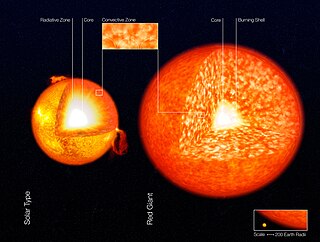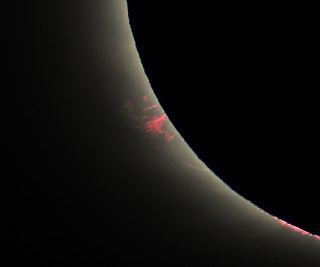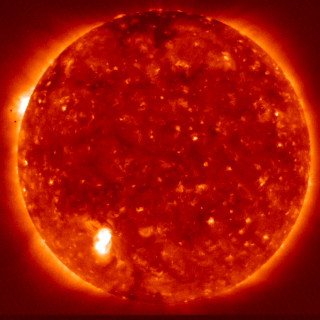
A corona is the outermost layer of a star's atmosphere. It consists of plasma.

The Sun is the star at the center of the Solar System. It is a massive, hot ball of plasma, inflated and heated by energy produced by nuclear fusion reactions at its core. Part of this energy is emitted from its surface as light, ultraviolet, and infrared radiation, providing most of the energy for life on Earth. The Sun has been an object of veneration in many cultures. It has been a central subject for astronomical research since antiquity.

A chromosphere is the second layer of a star's atmosphere, located above the photosphere and below the solar transition region and corona. The term usually refers to the Sun's chromosphere, but not exclusively.

In astronomy, the interstellar medium (ISM) is the matter and radiation that exists in the space between the star systems in a galaxy. This matter includes gas in ionic, atomic, and molecular form, as well as dust and cosmic rays. It fills interstellar space and blends smoothly into the surrounding intergalactic space. The energy that occupies the same volume, in the form of electromagnetic radiation, is the interstellar radiation field. Although the density of atoms in the ISM is usually far below that in the best laboratory vacuums, the mean free path between collisions is short compared to typical interstellar lengths, so on these scales the ISM behaves as a gas (more precisely, as a plasma: it is everywhere at least slightly ionized), responding to pressure forces, and not as a collection of non-interacting particles.

A flashtube (flashlamp) is an electric arc lamp designed to produce extremely intense, incoherent, full-spectrum white light for a very short time. A flashtube is a glass tube with an electrode at each end and is filled with a gas that, when triggered, ionizes and conducts a high-voltage pulse to make light. Flashtubes are used most in photography; they also are used in science, medicine, industry, and entertainment.
The Balmer series, or Balmer lines in atomic physics, is one of a set of six named series describing the spectral line emissions of the hydrogen atom. The Balmer series is calculated using the Balmer formula, an empirical equation discovered by Johann Balmer in 1885.

The stellar atmosphere is the outer region of the volume of a star, lying above the stellar core, radiation zone and convection zone.

In plasma physics, an Alfvén wave, named after Hannes Alfvén, is a type of plasma wave in which ions oscillate in response to a restoring force provided by an effective tension on the magnetic field lines.

Coronium, also called newtonium, was the name of a suggested chemical element, hypothesised in the 19th century. The name, inspired by the solar corona, was given by Gruenwald in 1887. A new atomic thin green line in the solar corona was then considered to be emitted by a new element unlike anything else seen under laboratory conditions. It was later determined to be emitted by iron (Fe13+), so highly ionized that it was at that time impossible to produce in a laboratory.

A convection zone, convective zone or convective region of a star is a layer which is unstable due to convection. Energy is primarily or partially transported by convection in such a region. In a radiation zone, energy is transported by radiation and conduction.

Transition Region and Coronal Explorer was a NASA heliophysics and solar observatory designed to investigate the connections between fine-scale magnetic fields and the associated plasma structures on the Sun by providing high resolution images and observation of the solar photosphere, the transition region, and the solar corona. A main focus of the TRACE instrument is the fine structure of coronal loops low in the solar atmosphere. TRACE is the third spacecraft in the Small Explorer program, launched on 2 April 1998, and obtained its last science image on 21 June 2010, at 23:56 UTC.

A prominence, sometimes referred to as a filament, is a large, bright red plasma and magnetic field structure extending outward from the Sun's surface, often in a loop shape. Prominences are anchored to the Sun's surface in the photosphere, and extend outwards into the solar corona. While the corona consists of extremely hot plasma, prominences contain much cooler plasma, similar in composition to that of the chromosphere.
An HI region or H I region (read H one) is a cloud in the interstellar medium composed of neutral atomic hydrogen (HI), in addition to the local abundance of helium and other elements. (H is the chemical symbol for hydrogen, and "I" is the Roman numeral. It is customary in astronomy to use the Roman numeral I for neutral atoms, II for singly-ionised—HII is H+ in other sciences—III for doubly-ionised, e.g. OIII is O++, etc.) These regions do not emit detectable visible light (except in spectral lines from elements other than hydrogen) but are observed by the 21-cm (1,420 MHz) region spectral line. This line has a very low transition probability, so it requires large amounts of hydrogen gas for it to be seen. At ionization fronts, where HI regions collide with expanding ionized gas (such as an H II region), the latter glows brighter than it otherwise would. The degree of ionization in an HI region is very small at around 10−4 (i.e. one particle in 10,000). At typical interstellar pressures in galaxies like the Milky Way, HI regions are most stable at temperatures of either below 100 K or above several thousand K; gas between these temperatures heats or cools very quickly to reach one of the stable temperature regimes. Within one of these phases, the gas is usually considered isothermal, except near an expanding H II region. Near an expanding H II region is a dense HI region, separated from the undisturbed HI region by a shock front and from the H II region by an ionization front.
The Evershed effect, named after the British astronomer John Evershed, is the radial flow of gas across the photospheric surface of the penumbra of sunspots from the inner border with the umbra towards the outer edge.

In solar physics, a coronal loop is a well-defined arch-like structure in the Sun's atmosphere made up of relatively dense plasma confined and isolated from the surrounding medium by magnetic flux tubes. Coronal loops begin and end at two footpoints on the photosphere and project into the transition region and lower corona. They typically form and dissipate over periods of seconds to days and may span anywhere from 1 to 1,000 megametres in length.

A red giant is a luminous giant star of low or intermediate mass in a late phase of stellar evolution. The outer atmosphere is inflated and tenuous, making the radius large and the surface temperature around 5,000 K or lower. The appearance of the red giant is from yellow-white to reddish-orange, including the spectral types K and M, sometimes G, but also class S stars and most carbon stars.
In cosmology, recombination refers to the epoch during which charged electrons and protons first became bound to form electrically neutral hydrogen atoms. Recombination occurred about 378,000 years after the Big Bang. The word "recombination" is misleading, since the Big Bang theory doesn't posit that protons and electrons had been combined before, but the name exists for historical reasons since it was named before the Big Bang hypothesis became the primary theory of the birth of the universe.

A nanoflare is a very small episodic heating event which happens in the corona, the external atmosphere of the Sun.

In astronomy and in astrophysics, for radiative losses of the solar corona, it is meant the energy flux radiated from the external atmosphere of the Sun, and, in particular, the processes of production of the radiation coming from the solar corona and transition region, where the plasma is optically-thin. On the contrary, in the chromosphere, where the temperature decreases from the photospheric value of 6000 K to the minimum of 4400 K, the optical depth is about 1, and the radiation is thermal.

An O-type star is a hot, blue-white star of spectral type O in the Yerkes classification system employed by astronomers. They have temperatures in excess of 30,000 kelvins (K). Stars of this type have strong absorption lines of ionised helium, strong lines of other ionised elements, and hydrogen and neutral helium lines weaker than spectral type B.














